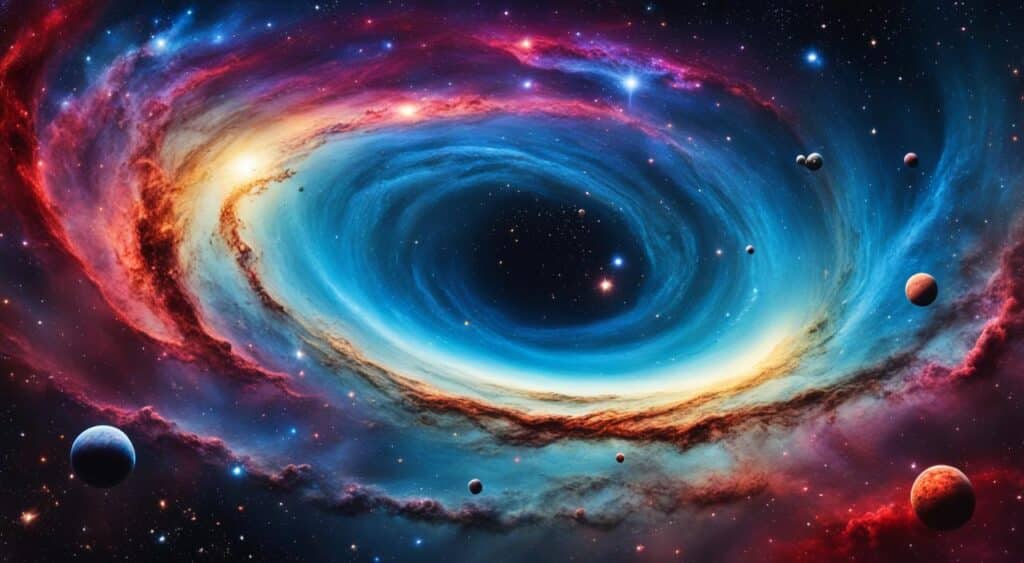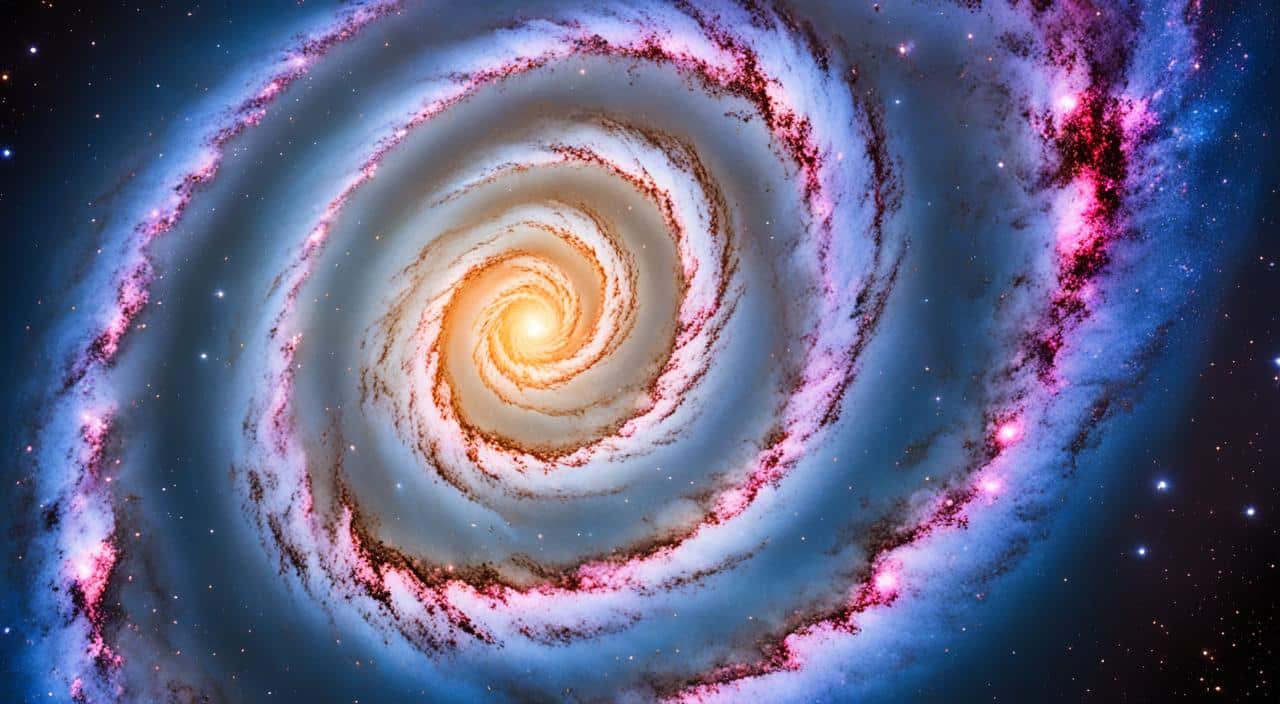Our universe is enormous and complex. It’s filled with uncountable galaxies, each with billions of stars. The Milky Way is one such galaxy. It’s our solar system‘s home, including planet Earth. The Milky Way is just one of 100 billion to 2 trillion observable galaxies.
Galaxies come in many shapes and sizes. You have the graceful spiral galaxies, the smooth elliptical galaxies, and the unique irregular galaxies. Each galaxy holds gas, dust, and stars together by gravity. The universe beyond our Milky Way is a mystery filled with countless stellar cities, each with its own story.
The distances between galaxies and how they interact are part of the universe galaxy‘s grand design.
Key Takeaways
- The universe is filled with countless galaxies, each containing billions of stars and their systems.
- Galaxies come in a variety of shapes and sizes, including spiral, elliptical, and irregular types.
- Each galaxy is a massive collection of gas, dust, and stars, held together by gravity.
- The vast distances between galaxies and their complex interactions are part of the grand cosmic tapestry of the universe galaxy.
- The Milky Way is just one of an estimated 100 billion to 2 trillion galaxies in the observable universe.
Understanding the Cosmic Hierarchy
To grasp our universe, we need to know the cosmic order. Our solar system is small in the huge Milky Way galaxy. It includes the Sun, planets, and more.
Our Solar System: A Tiny Speck in the Milky Way
The Milky Way is a vast spiral galaxy with 200 to 400 billion stars. It holds our solar system. The Milky Way is only one of many galaxies in the observable universe.
The Milky Way: Our Galactic Home
Galaxies vary, from spiral galaxies to elliptical galaxies and more. Each is a huge group of stars bound by gravity.
Galaxies: Immense Stellar Cities
The Andromeda Galaxy is our nearest major neighbor. It can be seen at night. We can closely examine galaxies with tools like the Hubble Space Telescope.
The Milky Way: A Spiral Masterpiece
The Milky Way galaxy is at the center of our cosmic neighborhood. It’s a beautiful spiral galaxy. It holds our solar system. This galaxy contains about 200 to 400 billion stars. It also has huge clouds of gas and dust.
These clouds form its spiral arms. They create a pinwheel shape. At its core, there’s a supermassive black hole. It influences the whole galaxy with its strong gravity.
On a dark night away from city lights, we can see the Milky Way. It appears as a faint band of light across the night sky. This is a sign of its many stars. It is our home among billions of other galaxies in the observable universe.
Unveiling the Universe’s Grandeur

The universe is vast and breathtaking, filled with wonders. Thanks to powerful tools like the Hubble Space Telescope, we’ve seen deep into space. We now know more about the many galaxies in the observable universe.
Countless Galaxies, Countless Wonders
The Hubble Deep Field image shows us thousands of galaxies in one small piece of the sky. It proves how every galaxy holds billions of stars. Soon, the James Webb Space Telescope will let us see the very first galaxies that formed.
But the universe is more than just galaxies. It’s also giant collections called galaxy clusters, held together by dark matter and dark energy. The scale and beauty of the cosmos are in these clusters and galaxies working together.
The Hubble Deep Field: A Window to the Cosmos
The Hubble Deep Field shot thousands of galaxies in a small sky area. It gives us a glimpse of the immense variety in the early universe. This image opened a new chapter in exploring space, showing its vastness and splendor.
| Telescope | Key Contribution |
|---|---|
| Hubble Space Telescope | Revealed the sheer scale and diversity of galaxies in the observable universe, including the landmark Hubble Deep Field image |
| James Webb Space Telescope | Promises to provide unprecedented insights into the early universe and the formation of the first galaxies |
Galaxy Morphology: Shapes of Stellar Brilliance
The universe is filled with galaxies of many shapes and looks, making each one special. Spiral galaxies, like our Milky Way, have beautiful arms that spread out from a center. This makes them look like giant pinwheels. The Andromeda Galaxy is another famous spiral like our own.
Spiral Galaxies: Graceful Pinwheels
Spiral galaxies are known for their stunning shapes. These shapes come from a mix of gravity, stars being born, and the galaxy spinning. The arms of these galaxies are where new stars are made from huge clouds of gas and dust. The Whirlpool Galaxy and the Sombrero Galaxy are well-known examples of these beautiful structures.
Elliptical Galaxies: Smooth and Stately
Elliptical galaxies look very different from spirals, being smooth and round. They appear this way because smaller galaxies have merged into one. This creates a stable, single-shape structure. These galaxies often have older stars, making them look more peaceful and grand than spirals.
Irregular Galaxies: Unique Cosmic Artworks
Irregular galaxies are truly unique, not fitting the usual shapes like spirals or ellipses. They can be asymmetrical and quirky. These special galaxies are designed by how gravity and star-making processes work. They vary a lot in size and shape, showing the different paths galaxies can take in the universe.
Universe Galaxy: The Grandest Collection

The universe galaxy is a grand collection with billions of stars. Each star has its own planets, moons, and other bodies around it. They are all part of galaxies, which are huge structures.
The observable universe has up to 2 trillion galaxies. They are filled with matter. Many have supermassive black holes at their centers. These black holes are very strong and affect everything around them.
There is more to the universe than just what we see with stars and galaxies. There are also dark matter and dark energy. They make up most of the universe’s matter and energy. The universe galaxy is huge and complex. Its billions of stars and galaxies show how amazing our universe is.
Billions of Stars, Billions of Possibilities
The universe galaxy is a vast and complex place with many stars. There are estimated to be 100 billion to 2 trillion galaxies in the observable universe. They are full of matter and stars. Supermassive black holes in the center of some galaxies shape the cosmic scale.
There’s more to the universe than just stars and galaxies. Dark matter and dark energy are mysterious but major parts. They make up most of the universe. This shows the huge scale and complexity of the universe. It’s an incredible place offering endless exploration and discovery.
Galactic Interactions: Cosmic Dances

The universe galaxy is a lively and always changing place. It’s not about being separate but connected through gravity. Galaxy collisions and mergers happen often. The pull of gravity brings them close, creating amazing scenes of interaction.
Colliding Galaxies: Spectacular Mergers
When two galaxies collide, it’s a sight to behold. Their structures mix and form new galaxies. These events also spark the birth of new stars. Gas and dust combine to create fresh generations of stars.
The Milky Way-Andromeda Collision: A Future Cosmic Event
In around 5 billion years, our Milky Way will meet Andromeda. This merging event won’t see stars actually bumping into each other. But, it will reshape our local universe galaxy forever. Cosmic dances like this show the vastness and change in the universe.
Exploring the Cosmos
Humans have always wanted to know about the universe galaxy. Thanks to observatories like the Hubble Space Telescope and the coming James Webb Space Telescope, we’ve learned a lot. The Hubble, since 1990, has shown us amazing views. These let scientists see galaxies up close and learn about them in fine detail.
The Hubble Space Telescope: Unveiling Galactic Secrets
The Hubble’s Hubble Deep Field image is a big deal. It showed us thousands of faraway galaxies in a small part of space. This photo let us see the vastness and variety of the universe galaxy.
The James Webb Space Telescope: Peering into the Early Universe
The James Webb Space Telescope will look even deeper into space. With its infrared tools, it will show us more about very early galaxy formation. We can’t wait to learn about the universe’s first galaxies.
These telescopes and other new tools are moving us forward. They’re helping us understand the universe galaxy better. This knowledge helps us see how the cosmos formed over a very long time.
Dark Matter and Black Holes: Unseen Galactic Architects
At the heart of the universe galaxy, two amazing but mysterious parts play a big role. They are dark matter and black holes. Dark matter is a hidden material that dominates the universe’s stuff by about 6 times. It’s the key player in creating the biggest cosmic structures. The pulls of its gravity help design the shapes of galaxies and galaxy clusters. It also forms the complex patterns we see in the universe.
Black holes balance out dark matter’s effects. They are at the cores of many galaxies, like our own Milky Way. These supermassive black holes are incredibly heavier than our Sun. They control everything near them, pulling in matter and affecting how stars and gas move. The combination of dark matter and black holes is the secret to how the universe galaxy has taken the shape we see today. They show us the amazing and lively cosmos on a huge scale.
Also read: What Secrets Lie Beyond The Star Beacon’s Radiant Glow?
Conclusion
The universe galaxy is a large and wonderous space, filled with many galaxies. Each one is like a unique and interesting piece of art. There are spiral galaxies, elliptical giants, and quirky irregulars, showing the variety in the cosmos.
At its core, we find dark matter and black holes. These unseen things play huge roles in how galaxies form and change over time. They are key to understanding our cosmic neighborhood.
With telescopes such as Hubble and the James Webb, we are discovering more about the universe galaxy. We look farther back in time, uncovering the early days of the cosmos. This journey teaches us about our place in this vast, complex universe.
The universe galaxy shows us the beauty and mystery of space. It encourages us to keep exploring and solving the universe’s secrets. Every discovery brings us closer to understanding the cosmos.
FAQs
Q: What is a galaxy and how does it relate to the universe?
A: A galaxy is a system of stars, star clusters, dust, and gas bound together by gravity. Galaxies in the universe are massive collections of stars and other celestial objects that are held together by gravitational forces.
Q: What are the different types of galaxies found in the universe?
A: The types of galaxies found in the universe include spiral galaxies, elliptical galaxies, irregular galaxies, and dwarf galaxies. Each type has its own unique characteristics and shapes.
Q: How are galaxies formed in the universe?
A: Galaxies are believed to form through the merging of smaller galaxies, the collisions between galaxies, and the gravitational interactions between different celestial objects. These processes contribute to the formation and evolution of galaxies in the universe.
Q: What are active galaxies and how are they different from normal galaxies?
A: Active galaxies are galaxies that emit significantly more energy than normal galaxies. This increased activity is often attributed to the presence of a supermassive black hole at the center of the galaxy, which is actively accreting matter and emitting radiation.
Q: How many galaxies are estimated to exist in the observable universe?
A: It is estimated that there are billions of galaxies in the observable universe, each containing billions to trillions of stars and other celestial objects. The vastness of the universe is truly awe-inspiring.
Q: What are some examples of active galaxies in the universe?
A: Examples of active galaxies include Seyfert galaxies, starburst galaxies, and radio galaxies. These galaxies exhibit intense energy emissions and unique characteristics that distinguish them from other types of galaxies.
Q: How do astronomers observe and study galaxies in the universe?
A: Astronomers use telescopes, both ground-based and space-based, to observe and study galaxies in the universe. They analyze the light emitted by galaxies across different wavelengths to understand their composition, structure, and evolution.
Source Links
- https://nightsky.jpl.nasa.gov/news-display.cfm?News_ID=573
- https://spaceplace.nasa.gov/galaxy/
- https://en.wikipedia.org/wiki/Galaxy





